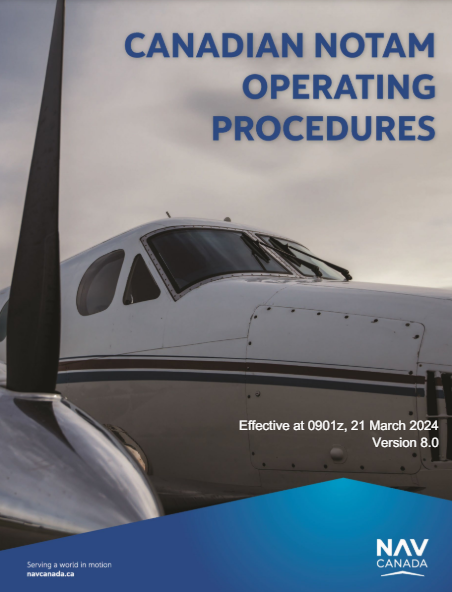by Caroline Doucet, Manager AIM and IFP Standards and Procedures, NAV CANADA and Chris Rieken, Director, Operational Safety, NAV CANADA
Canadian NOTAM operating procedures cover page
A NOTAM—known as a “notice to airmen”—is an integral yet sometimes misunderstood safety element of aeronautical information available to pilots, Air Traffic Services (ATS) and other aviation stakeholders. The accuracy and integrity of information communicated through a NOTAM is critical to ensure the safe operation of a flight that may need to know a hazard or operational change described in the NOTAM.
The International Civil Aviation Organization (ICAO) defines a NOTAM as a “notice containing information concerning the establishment, condition or change in any aeronautical facility, service, procedure or hazard, the timely knowledge of which is essential to personnel concerned with flight operations.”
NOTAM requests are submitted by various proponents to highlight pilot operational issues, such as unserviceable lighting on an obstruction near an airfield, a closed runway or the unavailability of a navigation aid. NAV CANADA published the Canadian NOTAM Operating Procedures (CNOP), available on the NAV CANADA Operational Guides Web site, which reflects the regulatory requirements contained in the Canadian Aviation Regulations (CAR) 803.01, among others.
Ideally, a NOTAM contains temporary information for a short duration of time and, for planned activities, is published with sufficient lead time for any potentially affected pilot, ATS unit or other aviation stakeholder to become aware of and act on the information.
A NOTAM is only as good as the information it contains
As a NOTAM originator, your role is crucial in ensuring the accuracy of the information. When requesting a NOTAM, whether by telephone or facsimile, it's important to provide accurate and legible information to NAV CANADA. NOTAM submissions are sometimes received with incomplete or inaccurate information that is not readily apparent. Not only can this lead to delays in publishing, but more importantly, inaccurate information can also result in hazardous outcomes or a potential aircraft accident. The ATS staff will not make any assumptions regarding the intent of the NOTAM and will confirm the submitted information if there is any uncertainty.
The system used by NAV CANADA specialists to enter NOTAM information is designed to create a standardized format and, at times, the NOTAM cannot be created if certain information is missing. Therefore, it's important for NOTAM originators to be available for questions should a NAV CANADA specialist need to verify information to ensure a NOTAM will be published correctly. Common inaccuracies include time conversion, units of measurement, missing information and easily misinterpreted handwritten information.
Best practices for submitting a NOTAM
- UTC or clearly state local time: Applying the Coordinated Universal Time (UTC) or “Zulu” in aviation parlance can be tricky. The National Resources of Canada (NRC) Canada.ca Web clock provides the official times across Canada in UTC and local time. Any smartphone can provide time in UTC as well. Not sure about UTC? Clearly state the local time zone when submitting the requests and pay attention to the end date, which will appear in UTC in the NOTAM to avoid the premature expiration of the NOTAM.
- Measurements in feet: Aviation still uses feet for distances and altitudes! Ideally, provide the NOTAM request in feet, and be sure to add the unit of measurement, no matter what. When we think of a displaced threshold that shortens the take-off roll, the difference between meters and feet can be significant! Sometimes, this can be not readily apparent to ATS specialists. However, shorter displacements or lower altitudes make it more difficult to identify this error.
- Use the online form: Handwritten information can be difficult to discern, especially regarding aerodrome location indicators or taxiways. For example, “Is this an ‘O’ as in Oscar or a ‘D’ as in Delta?” Did you know that NAV CANADA offers NOTAM submission forms? Use this link to submit online: navcanada.ca/notamsubmissions.
- Be available for clarity post-submission: Runway surface condition (RSC) NOTAMs received with incomplete information, such as the depth of a contaminant, is a common occurrence. An RSC NOTAM originator should ensure they are available to verify or confirm any information. Otherwise, there may be a delay in the NOTAM being published, meaning a pilot may not have the latest information on a runway they are planning on using.
- Submit with time to spare: On occasion, NOTAM closing runways or taxiways for routine maintenance are submitted minutes before the work starts. This doesn’t provide enough lead time for pilots to adjust operations, especially if they are already en route. Endeavouring to provide as much lead time as possible will help this planning. In general, submit between 24 and 48 hours before the effective date and time, but no less than 6 hours for planned events, outages and maintenance activities.
The completeness and accuracy of NOTAMs are a key part of keeping Canada’s skies safe, and NOTAM originators are extremely important partners in achieving this. By providing accurate and complete information and verifying that the published NOTAM is correct, you will contribute to ensuring the safety of all users of the Canadian airspace system.
